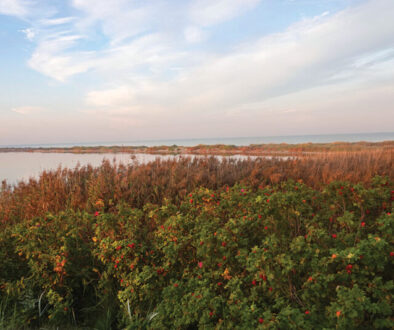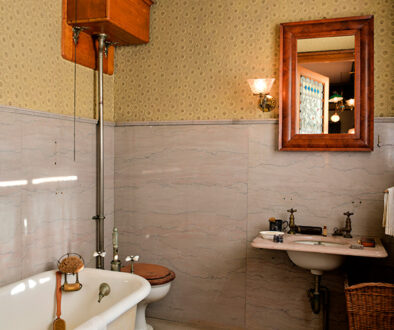809 Kearney Street
One of Cape May’s enduring attractions is its sense of mystery. Tales of pirates along the coast, ghosts in the eaves, and foreign spies having dinner in town give the city an enigmatic vibe that locals and visitors love to embrace.
That mystery also extends to many local historic properties. Record keeping from the 19th century didn’t always capture a property’s full story, often leaving out key details about a structure’s origins. But that sense of mystery only makes the property more interesting.
Take for instance the house at 809 Kearny Avenue, which has occupied its current spot for over a century—but evidence suggests it could have been built even earlier and moved to its current location.

“This house is a bit of a mystery; it’s hard to nail it down. It’s a mystery on the history,” said Donald Kane, who owns the property along with his wife Pat. “Records can be difficult to locate but we’ve been told the house was moved to its current location from somewhere else in the Cape May area. We can’t officially say where it may have been moved from. There are different stories out there—I’ve been told it could have come from Cape May Point, but we don’t know for sure.”
“One of the stories I’ve heard is that it was built as early as 1855,” added Pat. “And that the house was moved from Columbia Avenue. It’s because the home’s architecture is similar to many houses built by a single architect on that street.”
A Historic District Survey conducted in 2008 describes the structure as a “2½ story Gothic Revival style building that was either constructed or moved to this site between 1886 and 1890.” The house does not appear on a town survey until 1890—an 1886 survey shows the property site as vacant.
The survey adds “…this house displays many similarities to other houses constructed on Columbia Avenue 20 years earlier by developer Peter McCollum. There is a possibility this was a 20-year-old house moved to this location between 1886 and 1890.”

“Can you imagine horses pulling logs with homes on top of them, taking houses from one spot to another?” asked Pat.
Peter McCollum is remembered for developing several tracts along Columbia Avenue, including the Edward Morris Cottage at 621 Columbia, and the Samuel Harrison Cottage at 615 Columbia. But there’s no strong evidence that 809 Kearney is connected to these structures.
This section of Kearney east of Howard was mostly undeveloped until the late 19th century. The town was attracting plenty of visitors, and men like McCollum were building properties in hopes of selling for a profit. Gothic revival style homes were part of a 19th-century movement towards a more romantic, medieval look. Style elements include pointed arches, steeply pitched roofs, and delicate wooden trim known as vergeboard or bargeboards. This trim, also known as “gingerbread,” might be the style’s most famous element.
“I’ve found some evidence that the house was once called ‘The Angler’—I found a few signs. And we believe that’s because the house sits at an angle. It’s not perpendicular to the street—it’s angled to the right,” said Don.
“I wonder if it was just too difficult to get the house straight using just horses and logs,” asked Pat.
By the mid-19th century, railroad companies were seeing the opportunity Cape May presented. They filled in the swampland east of town near Columbia Avenue and invested heavily in New York-area advertising. They further encouraged development in town by offering free one-year train passes to anyone who built a cottage worth more than $2500. The railroad’s efforts resulted in visitors by the thousands coming to Cape May. All this development necessitated the need for infrastructure, civil services, and as the railroad invested, the city was born (the name changed from Cape Island to Cape May in 1869) and continued to grow.
The home is similar to historic homes on Columbia Avenue, some of which were designed by Stephen Decatur Button, a noted Philadelphia architect who was brought to Cape May with railroad money and whose style can be seen in over 30 different buildings in town. Button’s successful partnership with railroad investors John C. Bullitt and Frederick Fairthorne encouraged others, including McCollum on Columbia Avenue, to purchase properties and speculate on a profitable return.
Today 809 Kearney (called “Kane on Kearney” by its owners) is totally renovated, with seven bedrooms and four completely redone baths. The house sleeps 18 people, has an updated kitchen with new appliances, plenty of off-street parking, and is only two blocks from the beach.
“We rebuilt the interior and put a lot of work into it over a two-year period. We redid the roof, installed heat and air conditioning, and renovated it without losing the character of the inside,” said Don. “The exterior needed a lot of work as well, and I was slightly surprised the historic commission was not concerned with the color of the house—but as you drive around, I guess you see many colors in town. Around this neighborhood, many of the homes are much newer, 1920 and some later. And our architecture is much different than the other homes on the street. We have a unique color too; we’re blue as opposed to many more muted colors around us.”
This rental house is considered a “contributing resource in the historic district” and notes the “special elements” in the house, including the “divided light windows, trim and front porch elements.” The historic Chalfonte Hotel is right up the street.
“We have music every Thursday thanks to the Chalfonte,” laughed Don. “So many more people are falling in love with Cape May—we’re so different from other vacation towns, including others here in Jersey. We used to go to other spots before, but I was struck by Cape May, and we purchased it in 2018. We love it here, and it’s a pretty house.”
“We have a great front porch,” added Pat. “You can sit there and watch the carriages trot by, and we have so many rooms—it’s great for a family. There’s a nice back patio and a deck on the second floor. There are a lot of places in the house to just get comfortable.” ν



